Telangana SCERT TS 6th Class English Study Material Pdf Unit 1A Peace and Harmony Textbook Questions and Answers.
TS 6th Class English Guide Unit 1A Peace and Harmony
Look at the picture and discuss the questions that follow:
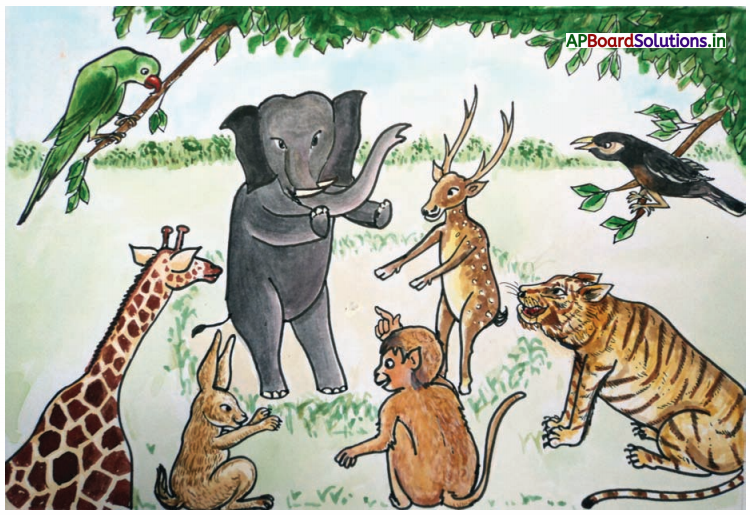
Question 1.
What does the picture tell you about the animals ?
Answer :
The animals and birds are discussing seriously something. They might have a problem and to solve the problem, they hold a meeting.
Question 2.
Are they happy or unhappy? How do you know?
Answer :
They are unhappy. I know it from their serious way of holding the meeting.
![]()
Question 3.
Name the animals you see in the picture.
Answer :
I see the elephant, the giraffe, the tiger, the deer, the rabbit and the monkey in the picture.
Oral Discourse :
Select any one animal from the above picture and describe it.
The elephant
The elephant is the largest animal. It is also strong. Its eyes are very small, but it can see long distances. It can also pick up very small things with its trunk. It has very large ears. Some elephants have tusks. They are called tuskers. Usually, elephants live in forests along with their herds. They are vegetariAnswer : Sometimes they get mad. They destroy everything on their way. They can take revenge also.
Elephants can be tamed. They are used in temple processions and festivals. They are also used to carry heavy logs of wood from the forest. They run very fast. They are trained in circus to do feats.
I. Answer the following questions :
Question 1.
How were the animals before the jackal joined them? Pick out the words which describe their mood.
Answer :
Before the jackal joined them, the animals lived together happily. They roamed about the jungle and played together. They often held a musical evening in a large open field and invited the moon, her friends and the stars to be the guests of honour. The words such as ‘happily’, ‘roamed’, ‘played’, ‘proud’, ‘admired’, ‘enjoyed’, ‘danced’, ‘sang’ describe their mood.
![]()
Question 2.
What happened to the animals after the jackal came to the forest ?
Answer :
After jackal came to the forest, the animals began suspecting one another. They started to put up boundaries and build fences around their properties. They moved about individually or with their own group.
Question 3.
What was the jackal’s plan? How did it succeed?
Answer :
The jackal’s plan was to bring differences among the creatures. He wanted to disturb the peaceful atmosphere in the forest. It succeeded in his attempts to create the differences among them. Listening to the cunning jackal’s words they began suspecting one another. They put up boundaries and built fences around their properties. Finally there was a chance for the jackal to hunt the animals and the birds and kill them one by one.
Question 4.
What did the animals do to check the jackal’s evil design?
Answer :
The animals held an emergency meeting and decided to approach the Sadhu to kill the cunning jackal. They met the Sadhu and requested him to kill the jackal. He replied that he would not kill the jackal but would help them in a different way.
Question 5.
How was the moon disguised? Why did he choose that form?
Answer :
The moon was disguised as a Sadhu. He wanted to make the creatures in the forest to live in harmony with this deed. He chose that form so as to save all the creatures in the forest from the cunning jackal. He wanted to teach the creatures to live in peace and harmony.
Question 6.
Why did the Sadhu ask the jackal to take him for his meal ? Would you do the same if you were in his place?
Answer :
The jackal came to the house of the hens to take a few of them for his supper. On seeing this, the Sadhu requested the jackal to take himself for his meal and leave the hens. It shows the greatness of sacrificing for others. Yes, I would do the same if I were in his place.
![]()
Question 7.
What did the Sadhu teach the animals in the forest?
Answer :
The Sadhu taught the animals to live in peace and harmony. He wanted them to break down the fences which they had built.
Question 8.
Do you think the Sadhu sacrificed his life for the sake of animals in the forest? Give reasons for your answer.
Answer :
Yes, I think the Sadhu sacrificed his life for the sake of animals in the forest. He entered the forest for that purpose only. He taught them to live in peace and harmony. When the cunning jackal tried to take the hens as his meal, the Sadhu offered himself as food to the jackal. Though the Sadhu knew that he was going to die, he sacrificed his life for the sake of animals.
II. Read the following paragraph and analyse it in terms of cause and effect/ consequence. One has been done for you.
The animals in the forest were friendly, so the jackal could not eat any animal. The jackal then thought of a plan and implemented it. The animals started suspecting each other as the jackal’s plan worked. The life in the forest became dull because there were no musical evenings. All the animals requested the sadhu for help, so he talked to the animals and the birds and solved their problem. However, the sadhu didn’t want to kill the jackal, but preferred to teach a lesson to it.

Answer :
| Cause | Consequence |
| 1. All the animals in the forest were friendly. | The jackal couldn’t eat any animal. |
| 2. The jackal’s plan worked. | The animals started suspecting each other. |
| 3. There were no musical evenings. | The life in the forest became dull. |
| 4. All the animals requested sadhu for help. | He talked to the animals and the birds and solved their problem. |
![]()
III. Rearrange the following sentences in the order of their occurrence in the story. Then rewrite them into a meaningful coherent paragraph using appropriate linkers.
1. The animals and the birds requested the moon to help them.
2. The moon came in the form of a Sadhu.
3. The jackal created an unfriendly atmosphere.
4. The peace and harmony in the forest was disturbed.
5. The jackal entered the forest.
6. The peace and harmony in the forest was restored.
7. The jackal did not like this, so it killed the sadhu.
8. The sadhu talked to everyone in the forest and tried to restore peace.
9. They often held musical evenings.
10. The animals and the birds began suspecting each other.
11. The animals and the birds were living happily together.
12. The stomach of the jackal bloated and then burst into pieces.
The correct order of the above sentences : 11,9,5,3,10,4,2,1,8,7,12,6
Answer :
Once there lived the animals and the birds happily together. Every month they had a musical evening. One day the jackal entered the forest. The jackal created an unfriendly atmosphere. So, the animals and the birds began suspecting each
other. Thus the peace and harmony in the forest was disturbed. Seeing all this, the moon came in the form of a Sadhu. As soon as they saw the Sadhu, they requested him to help them. Listening to them, the Sadhu talked to everyone in the forest and tried to restore peace. But the jackal did not like this, and it killed the Sadhu. After taking the Sadhu as his meal, the jackal’s stomach bloated and then burst into pieces. As the Sadhu wished, the peace and harmony in the forest was restored.
Vocabulary :
I. Read the following sentences from the story :
They heard a soft voice.
He was dirty and dangerous.
It was easy for the jackal to hunt the smaller animals and birds.
The jackal told the elephant, “You are the biggest animal in the forest.”
He said to the peacock. “You are the loveliest bird in the forest.”
The underlined words are called Adjectives.
1. They come either before or after a noun (a tall boy)
2. They take intensifiers like very, quite (a very tall boy)
They have degrees of comparison. Positive, Comparative and Superlative.
Here are the three forms of a few adjectives.

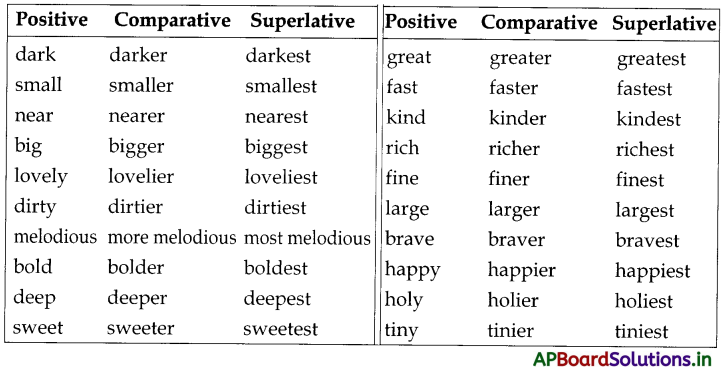
Interchange of the Degrees of Comparison.
1. Varshini is as tall as Harshini. (Positive)
Harshini is not taller than Varshini. (Comparative)
2. The donkey is bigger than the deer. (Comparative)
The deer is not so big as the donkey. (Positive)
3. Harini is older than Gopi. (Comparative)
Gopi is not as old as Harini. (Positive)
4. Lalitha is not so heavy as Babloo. (Positive)
Babloo is heavier than Lalitha. (Comparative)
5. Tenali is cooler than Jaipur. (Comparative)
Jaipur is not so cool as Tenali. (Positive)
When the comparison is between two, there is no Superlative Degree. When the comparison is among more than two, we can write in all the three degrees of comparison.
The definite article ‘the’ is used before the adjective in the Superlative Degree.
Read the following paragraph carefully, underline all adjectives and write the other degrees of comparison for them.
Answer :
Yesterday we went for a picnic to Nehru Zoological Park which is one of the biggest zoos in the country. The climate was cool and pleasant. We saw many animals, birds, reptiles etc. We also saw a very large elephant. After that, we saw a tall giraffe with a long neck. There were also some small birds which sang sweet songs. There was a beautiful peacock which danced majestically. We went very close to the brown cobra. We felt very happy. We reached home late in the evening.
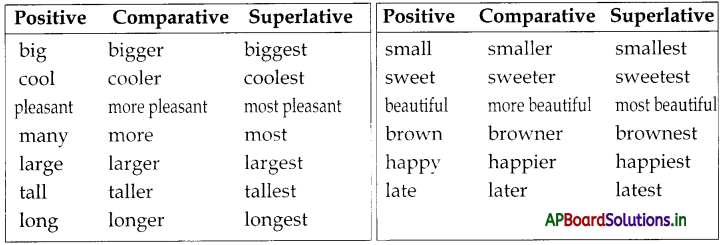
II. Read the following words. Each pair has one word the other word is opposite in meaning :

Fill in the blanks in the sentences given below with the word opposite in meaning to the one in bold letters.
1. The elephant’s eyes are small but its body is ______.
2. The animals were happy in the beginning. After the jackal entered the forest, they became ______.
3. The giraffe’s neck is very long but its tail is ______.
4. Mangoes are sweet but lemons are ______.
5. The coconut is a tall tree but the guava is a ______ tree.
Answer :
1. big
2. unhappy
3. short
4. sour
5. short
![]()
III. The following pairs of words are similar in meaning. Pick out such pairs from the story you have just read.

Answer :
1. animals – creatures
2. small – tiny
3. talk – speak
![]()
Grammar :
I. Read the following sentences.
The elephant is bigger than the donkey.
The donkey is not so big as the elephant.
In the above sentences the elephant and the donkey are compared with respect to their size. The words “big” and “bigger” are adjectives that are used to compare their size.
Here is some information about a group of pupils in 6th class.

Now make 20 sentences comparing the age, height and weight of the students as shown in the examples given below :
Harini is as tall as Rajesh.
Harini is not so heavy as Raghava.
Harini is older than Gopi.
Siddu is the heaviest boy in the group.
1. Akhila is older than Bhaskar Raju.
2. Gopi is younger than Manoj.
3. Rajesh is not so old as Siddu.
4. Seshagiri is not so old as Vamsi.
5. Raghava is older than Gopi.
6. Bhaskar Raju is younger than Akhila.
7. Siddu is the tallest boy in the group.
8. Vamsi is not so tall as Manoj.
9. Raghava is taller than Bhaskar Raju.
10. Gopi is not so tall as Raghava.
11. Bhaskar Raju is as old as Gopi.
12. Siddu is as old as Vamsi.
13. Manoj is as tall as Seshagiri.
14. Rajesh is as tall as Manoj.
15. Bhaskar Raju is the lightest boy in the class.
16. Gopi is not so heavy as Manoj.
17. Raghava is as heavy as Rajesh.
18. Rajesh is not so heavy as Seshagiri.
19. Seshagiri is heavier than Akhila.
20. Raghava is heavier than Vamsi.
![]()
II. Look at the following sentences paying special attention to the underlined words.
The tiny ants, which were always busy tickled the dark buffaloes.
They often held musical evenings in a large open field.
The underlined words are adverbs, which tell us how often something the happens.
They are called adverbs of frequency.
Read the following passage and underline the adverbs of frequency.
Sekhar is a busy taxi driver. He never finds time to read books. He often takes food outside. He reaches home early in the evening. But he seldom goes to bed early. So, his children always ask him for a bed time story. Sometimes he takes his children to picnics and buys toys and gifts.
Adverbs of Frequency
An adverb is a word which modifies a verb, an adjective or another adverb. It adds something to the meaning of a verb, adjective or an adverb.
‘Adverbs of frequency’ are the words that tell us how often something happens.
‘Always’, sometimes, never, often, seldom are some of the adverbs of frequency.
Eg:
1) The tiny ants, which are always busy, tickled the dark buffaloes.
2) They often held a musical evening in a large open field.
3) He always drinks milk.
4) I sometimes sip tea.
5) We seldom watch cricket matches.
Look at the conversation between two friends, Murthy and Krishna. Fill in theblanks with always, never, often, seldom, sometimes.
Murthy : Do you like reading books?
Krishna : Yes, very much. I __________ read books, a book a day, How about you?
(Answer : always)
Murthy : I like books too. But I _________ read books, not always.
(Answer : sometimes)
Krishna : How ___________ do you read books?
(Answer : often)
Murthy : Once or twice in a month.
Krishna : Oh, that’s fine. Have you read Asura by Anand Neelakantan?
Murthy : No. I haven’t. I’ll read it next month. How ____________ does your brother read?
(Answer : often)
Krishna : He ___________ reads books. The last he read a book was 10 years ago.
(Answer : seldom)
![]()
Writing :
I. Here is an invitation card from the animals about a musical programme in the forest. Read it carefully.
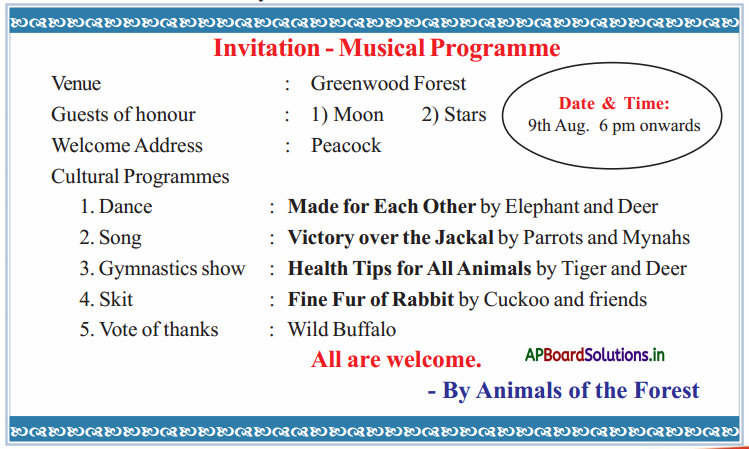
Suppose you are planning to conduct a cultural programme in your school on the occasion of your School Anniversary. Design an invitation card. You may use the model given above.
Answer :

![]()
II & III. Imagine that you are the Cultural Secretary of your school. You have been asked to compere the progra mme on the School Anniversary Day. Prepare your script and then give a mock performance before your group.
Answer :
Dear Mr. I.V.Raju, Smt. K. Lakshmi and dear friends,
I welcome you all to our School Anniversary organised at BVS Public School, Vijayawada. As you are aware, we have with us Sri I.V.Raju and Smt. K.Lakshmi as our guests of honour. On behalf of our school and on my behalf, I thank them for sparing some of their valuable time for us. I would request Mr. I.V.Raju, the Joint Commissioner of our city to say a few words on this occasion.
(Mr. I.V.Raju says a few words)
Mr. I.V. Raju Sir,
Thank you sir for saying very kind words for us. Now I would like to request Smt. K.Lakshmi, the ACTO of our city to say a few words on this occasion.
(Mrs. K.Lakshmi says a few words)
Thank you madam for your delivering the speech for us.
Now I will begin our cultural programme with a song called “Punya Bhoomi Na Desam ……”. This will be presented by Vineetha & Suneetha of VI Class B/S.
(A song by Vineetha and Suneetha of VI B / S)
I am sure you have liked the item. The next item in our programme is a dance item called “Pitbull on the floor……” by VI Class C/S Girls.
(Dance item by VI Class C/S Girls)
How was the dance item? Did you like it? Now you will see the play called “Kanyasulkam.” This will be presented by VI Class A/S Girls and Boys.
(A play by VI A / S Girls and Boys)
I am sure you have enjoyed the show. Now you will see a skit called “Laugh if you can……” It will be presented VI B/S Boys.
(Skit by VI B / S Boys)
Now, I invite Master K. Raja Sekhar, CPL of VI B/S to propose a vote of thanks.
(Vote of thanks by K. Raja Sekhar, CPL, VI B/S)
Finally, I invite you all to have a few snacks with a mouthful of juice before you leave.
![]()
Study Skills :
Read the following Table of Contents of a book :

Fill in the blanks with the information in the Table of Contents given above.
1. “Fossils” is found on page
Answer :
32
2. If you want to know about crocodiles you must turn to page
Answer :
38
3. “Mosquito” is found in Unit
Answer :
8
![]()
4. The Unit 7 : “Kites” is found from page
Answer :
47 to 51
5. Unit 4 talks about
Answer :
Vikram Sarabhai Trees (Poem)
Listening and Speaking :
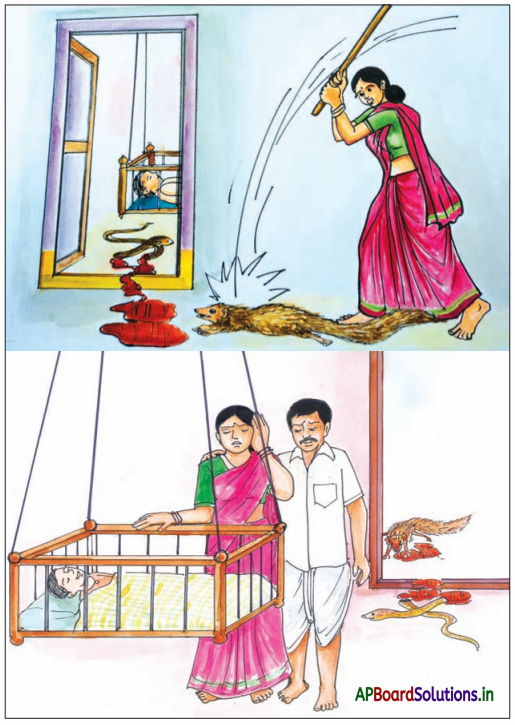
The Friendly Mongoose
Once, a farmer and his wife lived in a village with their small son. They loved him very much. “We must have a pet,” the farmer said to his wife one day. “When our son grows up, he will need a companion. This pet will be our son’s companion.” His wife liked the idea.
One evening, the farmer brought with him a tiny mongoose. “It’s a baby mongoose,” said his wife, “but will soon be fully grown. He will be a friend to our son.”
Both the baby and the mongoose grew. In five or six months, the mongoose had grown to its full size – a lovely animal with two shining black eyes and a bushy tail. The farmer’s son was still a baby in the cradle, sleeping and crying alternately.
One day, the farmer’s wife wanted to go to the market. She fed the baby and rocked him to sleep in his little cradle. Picking up the basket, she said to her husband, “I’m off to the bazar. The baby is sleeping. Keep an eye on him. Frankly, I don’t like to leave the child alone with the mongoose.”
“You needn’t be afraid,” said the farmer. “The mongoose is a friendly animal. It’s as sweet as our baby and they are the best of friends, you know.”
The wife went away, and the farmer, having nothing to do in the house, decided to go out and take a look at his fields not far away. He ran into some friends on the way back and didn’t return for quite some time.
The farmer’s wife finished her shopping and came back home with a basket full of groceries. She saw the mongoose sitting outside as if waiting for her. On seeing her, he ran to welcome her, as was customary. The farmer’s wife took one look at the mongoose and screamed. “Blood!” she cried. The face and paws of the mongoose were smeared with blood.
“You wicked animal! You have killed my baby,” she screamed hysterically. She was blind with rage and with all her strength brought down the heavy basket full of groceries on the blood-smeared mongoose and ran inside to the child’s cradle.
The baby was fast asleep. But on the floor lay a black snake torn and bleeding. In a flash she realised what had happened. She ran out looking for the mongoose. “Oh! You saved my child! You killed the snake! What have I done?” she cried touching the mongoose, who lay dead and still, unaware of her sobbing. The farmer’s wife, who had acted hastily and rashly, stared long at the dead mongoose. Then she heard the baby crying. Wiping her tears, she went in to feed him.
![]()
Listen to the story “The Friendly Mongoose” and answer the following questions.
Question 1.
Which character do you like the most in the story and why?
Answer :
I like the character of mongoose the most in the story because it sacrificed its life in saving the child with its faithfulness.
Question 2.
Do you think the mongoose would have bitten the child ?
Answer :
No, the mongoose didn’t bite the child. It bit the snake and saved the child.
Question 3.
Is the woman right in killing the mongoose? What would you have done?
Answer :
No, the woman is not right in killing the mongoose. I woudn’t be hasty in taking the decision. I would have gone into the room where the child slept in the cradle. Then I would have decided what to do.
Question 4.
Why did the husband go to fields leaving the child to the mongoose ?
Answer :
The husband went to fields as he had nothing to do in the house. He ran into some friends on the way. Moreover he had very much confidence in his pet mongoose; So he left the child to the care of mongoose.
Question 5.
Why do you think the mongoose killed the snake?
Answer :
I think the mongoose killed the snake when it tried to bite the little child. Otherwise the child must die with the poison of the snake when it bit him.
![]()
Question 6.
Suggest one word that describes the character of the mongoose in the story.
Answer :
Loyalty. (Faithfulness)
Question 7.
Is it a good idea to have a mongoose as a pet ? Give reasons.
Answer :
I think it is a good idea to have a mongoose as a pet. We are more pleasant with its presence before us. It defends us from the danger of crawling creatures. It protects us.
Peace and Harmony Summary in English
Long long ago there lived many animals, birds, snakes and insects in a very thick forest. They lived in peace and harmony. They played together happily. They often held a musical evening in a large open field and invited the moon, his friends and the stars to watch their special skills. At that time a cunning jackal entered the forest. He wanted to disturb the peace and kill the animals one by one for his prey. He poisoned their minds and roused enmity among them. They started suspecting one another, put up boundaries and built fences around their properties. They moved about individually.
The cunning jackal, who was waiting for this opportunity, started killing the animals one by one and ate them up. There were no more musical evenings. Then the moon decided to solve the problem and came down to the earth in the form of a Sadhu. When the creatures in the forest saw the Sadhu, they approached him and requested him to solve the problem. The Sadhu met all the creatures personally and advised them to move friendly with other ones. Seeing this the cunning jackal felt very anger with the Sadhu and wanted to kill him.
One day when the jackal tried to attack the hens, the Sadhu offered himself as jackal’s meal and requested the jackal to leave the hens. The jackal, immediately dragged the Sadhu into the forest, tore him into pieces and ate him up. But after sometime, the jackal’s stomach bloated and burst into pieces. At that time, they heard a soft voice wishing that all the creatures should live in peace and harmony. When the jackal’s life was ended in that way, all the animals started again to roam, sing and sleep in peace. The fences were broken down and the moon and the stars were invited for their cultural evenings.
![]()
Glossary :
1. together (adv) = with each other
Eg: Ramu and Somu go to school together.
2. roam = to travel around an area without any aim
Eg : He roams about the area where different varieties of birds live.
3. admire = to respect somebody for what they have done
Eg : We have to admire the efforts of Vinoba in finding the new ‘Land Gifts Mission’.
4. melodious (adj) = pleasant to listen
Eg: Miss. Chitra sings the songs very melodiously.
5. gymnastics (n) = physical exercises
Eg: We must do gymnastics regularly to make our bodies fit.
6. praise (v) = to express approval for somebody
Eg : The teacher praised Sankar for he had saved a little child’s life.
7. approach (v) = meet
Eg : They approached Gandhiji when he came to their city.
8. whisper (v) = to speak very quietly
Eg : Latha whispered a few words in Vanaja’s ears.
9. suspect = doubt
Eg : I suspected him to be a criminal.
10. fence (n) = A boundary put between two areas of land
Eg : We have a fence around our house.
11. property (n) = objects or things owned by somebody
Eg : We have the most of our properties in our native village.
12. narrate = to tell a story
Eg: Our teacher narrated the story for half an hour.
13. woe (n) = extreme sadness
Eg : Please, listen to my owes.
14. sob (v) = to cry noisily, taking sudden, sharp breaths
Eg : I heard her sobbing loudly.
15. blame = to say that somebody is responsible for something bad.
Eg : You must not blame anybody without knowing the truth.
16. accompany = to go along with somebody
Eg : My father accompanied us on the trip.
17. peace (n) = the situation where there is no violence
Eg : We want peace everywhere.
18. harmony (n) = a state of living together peacefully
Eg : Harmony is the thing we wish for a peaceful life.
19. opportunity (n) = chance
Eg : He is looking for an opportunity to take revenge on his enemy.
20. unanimously (adv) = unitedly
Eg : They selected him as the secretary unanimously.
21. supper (n) = the last meal of the day
Eg : We had a wonderful supper last night.
22. drag (v) = to pull something along with difficulty
Eg : He dragged her from her seat.
23. bloat (v) = become bigger and bigger (swell unpleasantly)